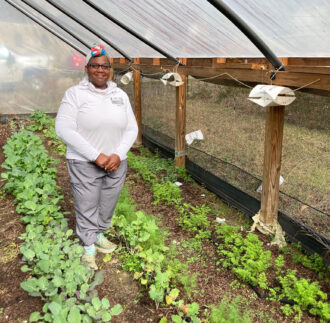Introduction
In the Southeast, pests are a significant limiting factor in successful vegetable production, both in open fields and in high tunnels. Heat and humidity, close crop planting, and the combination of host crops in a planting rotation are all factors in favorable pest buildup and crop damage. Common pests across the Southeast include moth species (armyworms, corn earworm, tomato hornworm, cabbage looper, fruitworms), stinkbugs, leaffooted bugs, aphids, grasshoppers, flea beetles and whiteflies.
In organic vegetable production, and in situations where farmers are seeking to reduce chemical applications, Integrated Pest Management (IPM) strategies are recommended to exclude pests in both opens fields and in high tunnels. The principles of pest exclusion involve separating the insect pest from the host plant and protecting the crop at a specific growth stage. Careful planning of both materials selected and management design are important to keeping pests out of a cash crop.
Generally, IPM strategies involve a combination of prevention and therapeutic tactics for pest exclusion and to conserve and/or augment natural enemies. In open field and high tunnel production systems, IPM practices involving such strategies as insect monitoring, trap crops and bioinsecticides are combined with either permanent high tunnel or temporary hoop house netting for a complete pest exclusion system.
Temporary Pest Exclusion System
Temporary Pest Exclusion Systems are short-term solutions to prevent early season pest infestation in open field crop production. Such systems are ideal for small-scale agriculture and market gardens. The netting for temporary pest exclusion systems are light fabric on fixed or movable hoop frames, grow tunnels or low tunnels. (Examples of material include Super-Lite Insect Barrier, AgroFabric Pro-19, Covertan Pro-19, and Proteknet).
Alabama Cooperative Extension research on Temporary Pest Exclusion Systems have shown success in reducing pest pressure (by up to 40 percent in some cases depending on the material used) in a number of crop production systems, including eggplant, squash, tomato, and cowpea.
Temporary Pest Exclusion Systems are easy to use and require minimal training to be implemented. They allow for early crop establishment and rapid crop growth, early season pest protection, and wind reduction. Fabric is installed on the hoops immediately after transplanting and is removed once plant blooming begins to allow access by beneficial insects and encourage proper vegetable/fruit set.
Temporary Pest Exclusion Systems make it a challenge to scout crops for weeds and disease, and they trap heat. Timing of fabric removal is also important. A rule of thumb is once the plants begin touching the inside of the fabric, the netting should be removed.
Permanent Pest Exclusion System
Permanent Pest Exclusion System is specifically designed for high tunnels as a long-term strategy for managing pests. High Tunnel Pest Exclusion Systems, or HTPE, are commonly combined with other IPM practices, such as targeted biological control agents, for more complete pest control. A permanent exclusion system is specifically designed to prevent pest establishment on crops in a high tunnel using a 50 percent woven shade cloth that is permanently installed under the side walls of the high tunnel. Shade cloth is low-cost and readily available, especially in black.
Alabama Cooperative Extension Service has been implementing HTPE Demonstration Sites across Alabama since 2014 to demonstrate the effectiveness of a 50 percent woven shade cloth in reducing pests in high tunnels. A study conducted from 2017-2021 at 22 locations showed reduction of 12 pests. Examples included 98 percent reduction in tomato fruitworm, 93 percent reduction in various armyworm species, 87 percent reduction in tomato budworm, and 100 percent reduction in tomato hornworm.
Farmers interested in Permanent Pest Exclusion Systems for their high tunnels are recommended to install netting before planting crops, remove weeds and practice sanitation measures inside the high tunnel.
HTPE systems will not protect against all insect pests. Some smaller pests, such as aphids and whiteflies, will be able to breach the shade cloth barrier. In those situations, releasing beneficial insects, such as assassin bugs, praying mantids, and ladybeetles, in the high tunnels may be effective in controlling smaller pests.
HTPE systems will also prevent some pollinators, such as bumblebees, from accessing the crops in the high tunnel. In some cases, it may be necessary to install bumblebee boxes in the high tunnel for pollination services.
Bioinsecticide use is recommended only as needed.
Pest Exclusion System Resources
For more information on pest exclusion systems, visit the following resources:
Auburn Cooperative Extension High Tunnel Resources for Pest Exclusion, Construction, and Beneficial Insects
SARE Pest Management: High Tunnels and Other Season Extension Techniques
Published by the Southern Region of the Sustainable Agriculture Research and Education (SARE) program. Funded by the USDA National Institute of Food and Agriculture (NIFA), Southern SARE operates under cooperative agreements with the University of Georgia, Fort Valley State University, and the Kerr Center for Sustainable Agriculture to offer competitive grants to advance sustainable agriculture in America’s Southern region. This material is based upon work that is supported by the National Institute of Food and Agriculture, U.S. Department of Agriculture, through Southern Sustainable Agriculture Research and Education, under SSARE grant project: EDS19-11. USDA is an equal opportunity employer and service provider. Any opinions, findings, conclusions, or recommendations expressed in this publication are those of the author(s) and do not necessarily reflect the view of the U.S. Department of Agriculture.
Want more information? See the related SARE grant:
